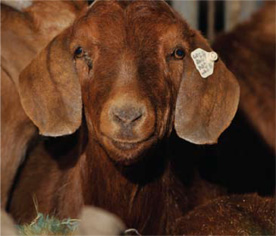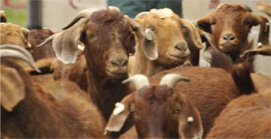ISU Veterinary Diagnostic Laboratory expands small ruminant diagnostic capabilities.
With the help of the small ruminant production medicine team, the ISU Veterinary Diagnostic Laboratory is working hard to expand and improve the diagnostic testing services offered through the laboratory for small ruminants (sheep and goats). Recent advances in our understanding of a variety of small ruminant disease processes coupled with a growing industry needs and desires have resulted in the need to expanded testing capabilities for these species.
Expanded Dairy Goat Milk Quality and Mastitis Culture Options
The dairy goat industry in Iowa and the surrounding states is growing rapidly. Due to some inherent species differences between cattle and goats there are clinically important differences in how milk quality and mastitis issues are approached. Since 2007, the Veterinary Diagnostic Laboratory has greatly expanded their milk quality assessment capabilities on both the bovine and more recently the caprine species. The laboratory now offers a variety of tests developed to aid in the early identification of sub-clinical mastitis carriers as well as “troubleshoot” bulk tank bacterial count issues or elevated somatic cell counts. Our small ruminant specialist team is available to work with herd veterinarians in developing testing protocols, interpretation of results and implementation of control measures. Below is a brief description of the tests offered:
Bulk Tank Culture: This culture provides detailed information on the specific types of bacteria identified in a bulk tank sample. It is used to screen herds for contagious mastitis bacterial species (bacteria that can be passed between animals during milking or management activities).
Milk Quality Test: This includes Standard Plate Count, Coliform Count, Pre-incubation Count, Laboratory Pasteurized Count Cultures. This panel of tests can be used to troubleshoot elevated bulk tank bacterial counts. By comparing the results of the specific species and number of bacteria obtained on each of these cultures it is generally possible to determine if the counts are associated with an equipment problem or mastitis. These results are critical in deciding how to proceed with getting a producer back to shipping milk.
Individual animal cultures: The laboratory offers several variations on the individual milk culture depending on the needs of the situation. Basic cultures can be done economically (generally for less then $3 per animal) and allow for a quick identification of culture status of animals. These cultures can be used in a fresh-doe management program (i.e. routine screening of high risk does) or a targeted culture program (i.e. cultures submitted based on individual animal SCC score or CMT results) to identify and address sub-clinical intramammary infections before they cause a bulk tank problem. Additional levels of the individual animal culture are available when bacterial quantification or more specific bacterial identification are necessary. Please have your veterinarian call the laboratory or one of the small ruminant production medicine team members to identify what test will provide the information needed for the best price.
Consultations: Since interpretation of both mastitis cultures and milk quality cultures may be slightly different in goats then in dairy cattle, our team is available to consult with the herd veterinarian on test selection and interpretation.
cELISA for Caprine Arthritis Encephalitis
The ISU VDL offers the cELISA test for Caprine Arthritis Encephalitis (CAE) marketed by VMRD. This diagnostic has been extensively tested by the manufacturer and has consistently performed well when compared to other test options. It may take some time for the submission forms to reflect the availability of this test but we encourage you to write a note on the submission form requesting the cELISA when submitting CAE test samples. See below for some commonly asked questions on CAE and testing:
What is Caprine Arthritis Encephalitis (CAE)?
CAE is a viral disease of goats that is very closely related to OPP of sheep and HIV of humans. In goats there are two predominant presentations. The most common presentation is an arthritic form in adult goats. This form is classically associated with debilitating arthritis but can also be observed in less severe manifestations. Animals may shed the virus with very minimal clinical signs. Other signs of this presentation would include chronic weight loss, symmetrically firm mammary glands, and loss of production ability. The second presentation is an encephalitic (neurologic disease) of young kids but this form is much less common than the arthritic form.
How is CAE spread?
The predominant means of CAE transmission is through the ingestion of infected colostrum or milk by kids born to an infected doe or kids bottle fed colostrums or milk from an infected doe. There is evidence to suggest that a small number of animals may get the disease after exposure to infected animals later in life however the relative likelihood of this compared to infection obtained through milk or colostrums is low.
How can I prevent the transmission of CAE from my does to their kids?
The implementation of an integrated CAE prevention program has proved very helpful on numerous farms. Such a program would vary somewhat depending on the management of your operation but would include the use of “heat-treated” colostrum and either pasteurized milk or milk replacer combined with strict segregation of infected animals. Such a program can also be very helpful in minimizing the transmission of other important disease processes including Johne’s disease and mycoplasma. Our team of small ruminant veterinarians at ISU can assist you and your veterinarian in development of an appropriate program.
Does CAE affect production of my goats?
There is research demonstrating that there are production losses associated with CAE infection in goats. In dairy goats positive animals were found to be more likely to fall into the bottom quartile of herd production and had a lower butterfat (Smith 1988). In another study mature positive does gave 195 lbs less milk per lactation and had a 21 day shorter average lactation when compared to seronegative animals (Greenwood 1995).
When and who should I test?
We recommend that all newly purchased animals be screened for CAE using the cELISA before they are introduced to the herd. Additional testing will depend somewhat on the desire and management system of the operation. Many farms elect to test the entire herd annually however more intensive testing will be required if a herd is trying to eradicate the disease on their farm. Please contact your local veterinarian for input and help with the development of an appropriate testing program.
I see that ISU-VDL also offers the AGID for CAE, why should I pick the cELISA instead of the AGID?
The AGID test kits utilized in this laboratory is designed to test for both CAE and OPP. As such, it relies on the similarities between the two viruses to “cross-react” with the virus and yield a positive result. This kit utilizes a portion of the OPP virus as the test reagent – thus it is very good at diagnosing OPP but less helpful in diagnosing CAE. If the AGID gives a positive test result on a goat it is a good indication that the goat has CAE however a negative test result is much harder to interpret since not all CAE positive goats develop cross reactive antibodies to the OPP virus used in this test (false negative test result). The cELISA was developed to only test for CAE and the manufacturer reports that it has a 100% sensitivity and a 99.6% specificity.
Can false negative and false positive results occur with the cELISA?
The data from the company as well as several field trials indicate that false negative results are rare. In general, based on the manufacturer’s research, it is more likely that a false positive result would occur. One potential source of false positives is testing of kids less then 4-6 months of age that still may have maternally derived antibody (obtained from colostrum that was heat treated) but do not have the virus. We recommend that any kids less then 6 months of age that tests positive be retested after 6 months of age if they are to be retained in the herd.
If my goat is infected with CAE is there any way to “cure” it?
Unfortunately the CAE virus integrates into the cells of the goat and there is no way to completely “cure” the animal of the disease. Thus, once a goat is infected the animal will always be infected.
Do all goats with CAE show clinical signs?
No, some animals may have the virus but show minimal or no clinical signs. It is possible however for these animals to shed the virus and they can be a source of infection for other animals in the herd.


